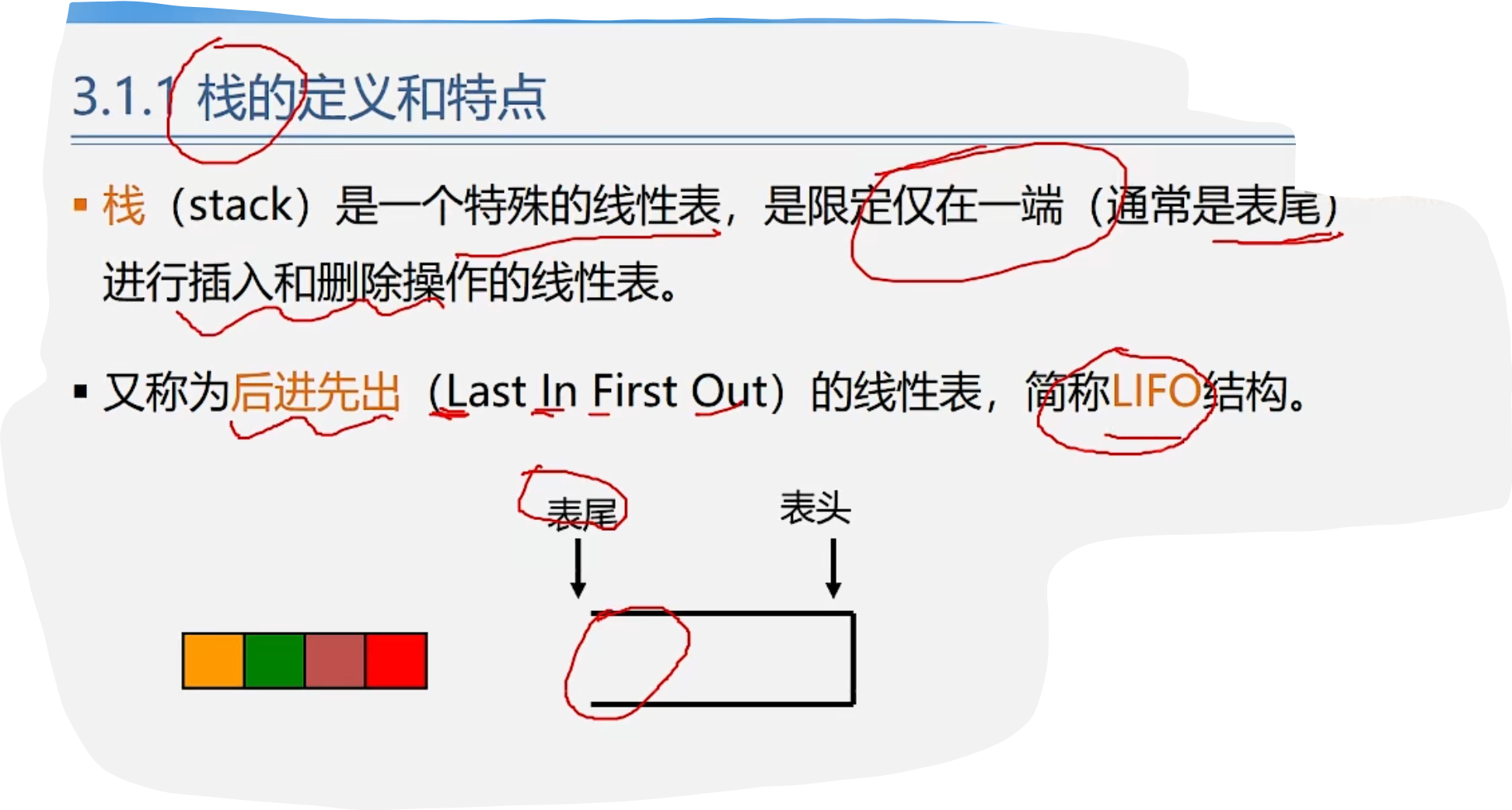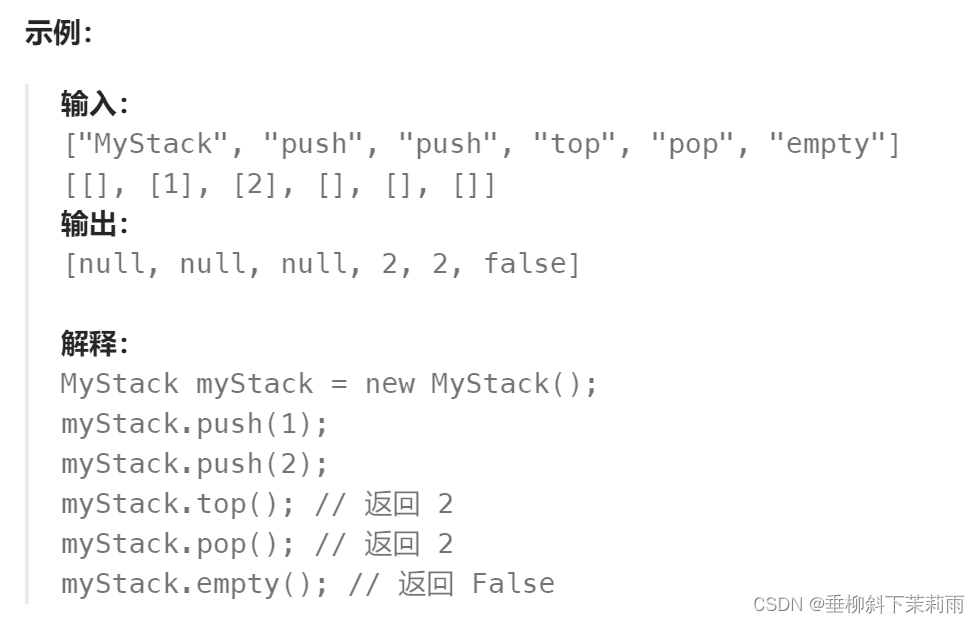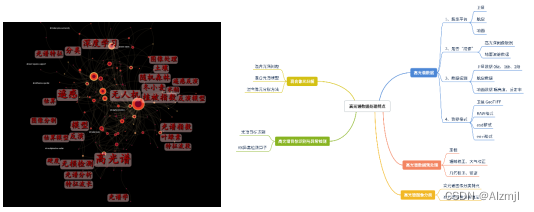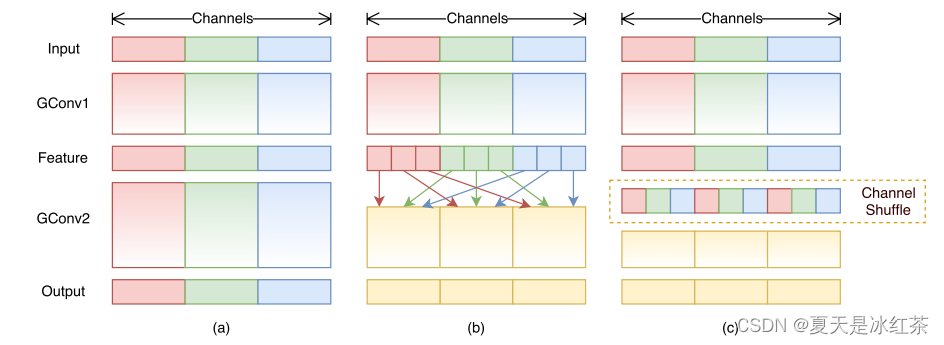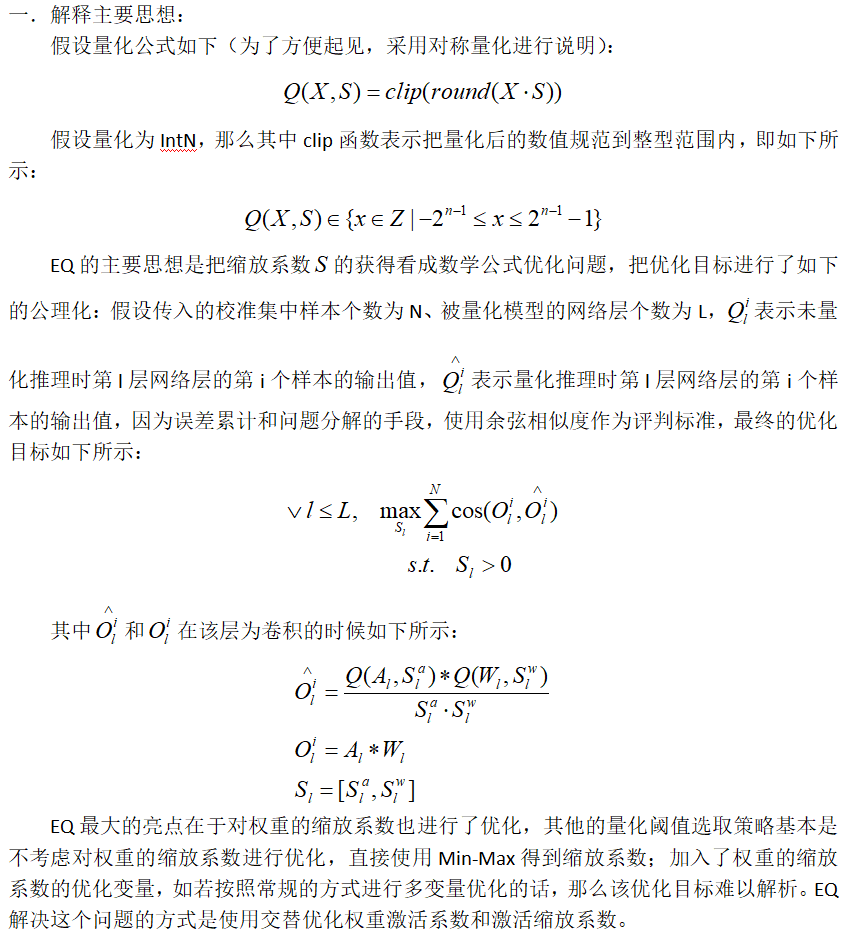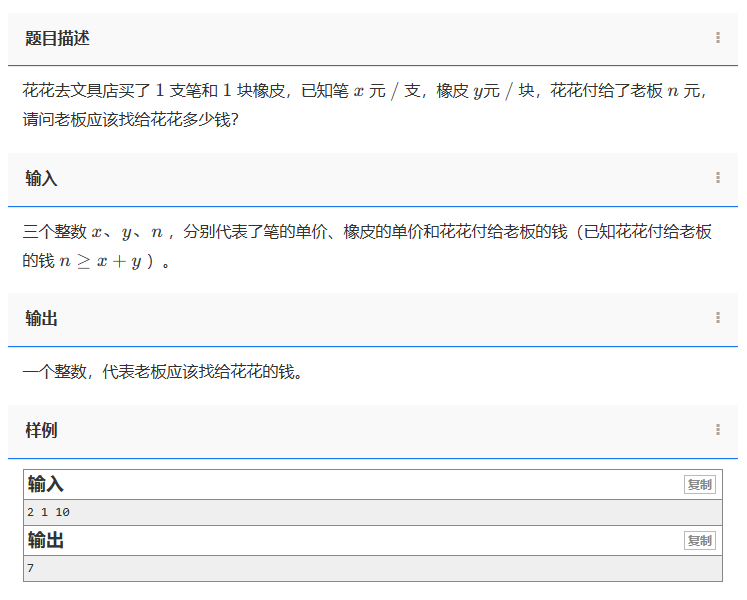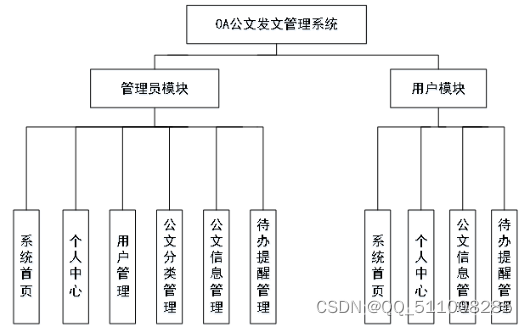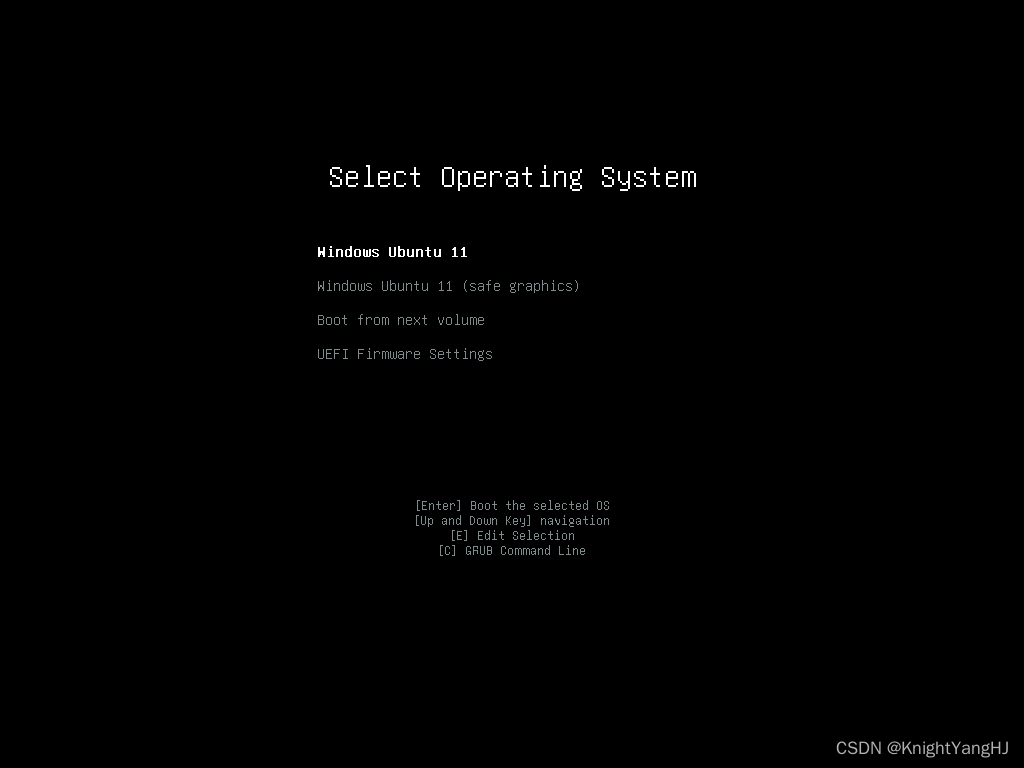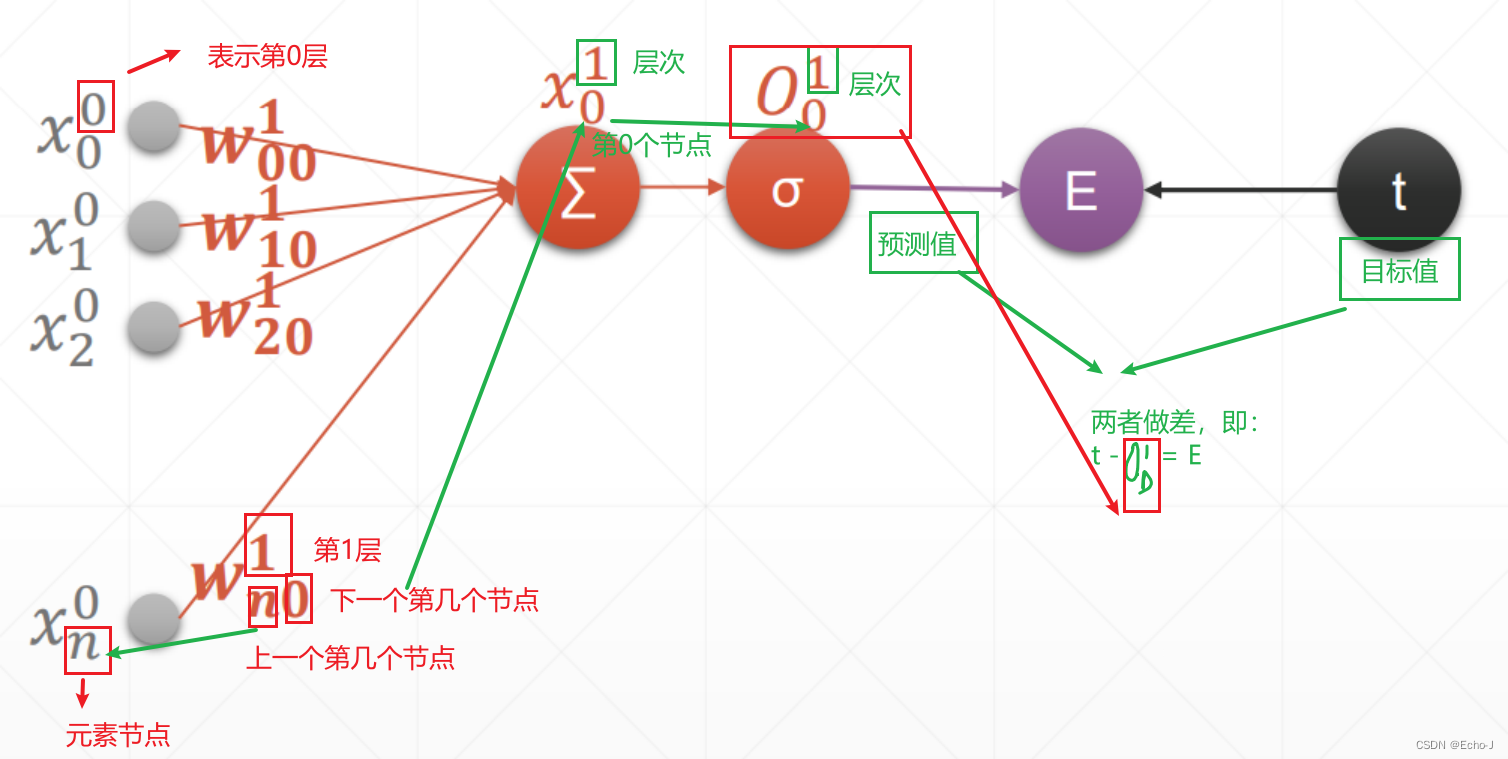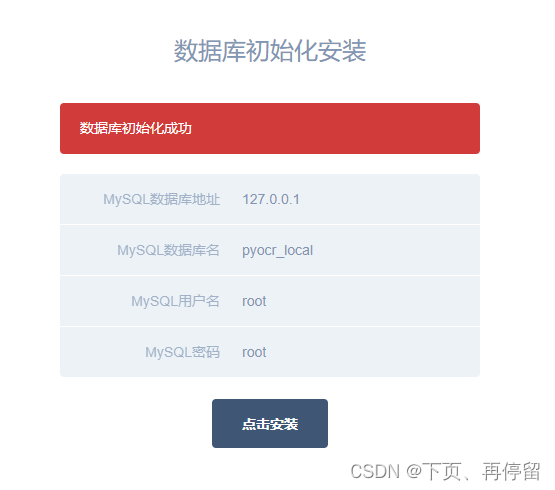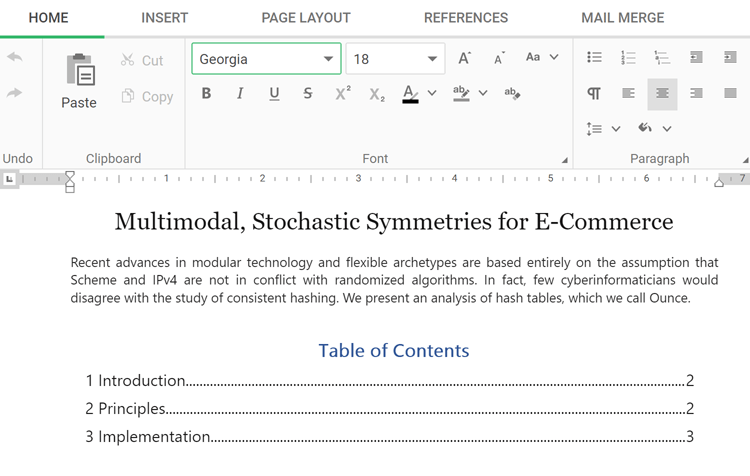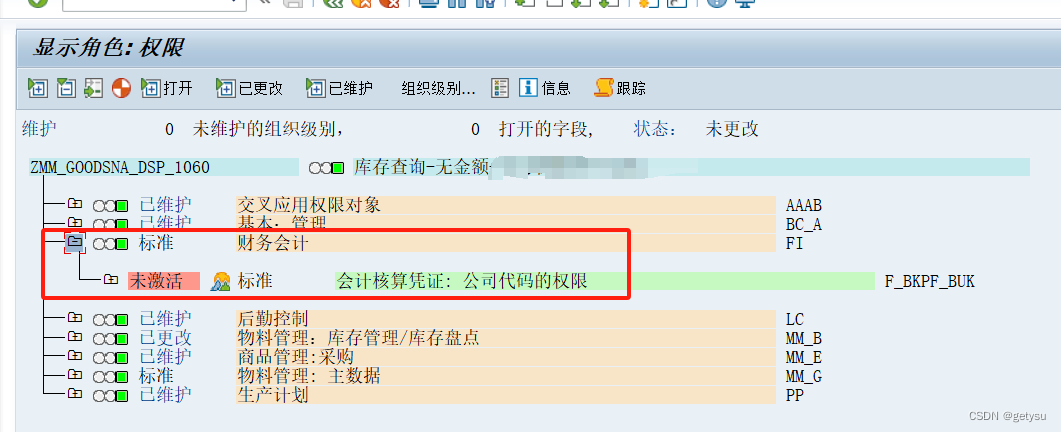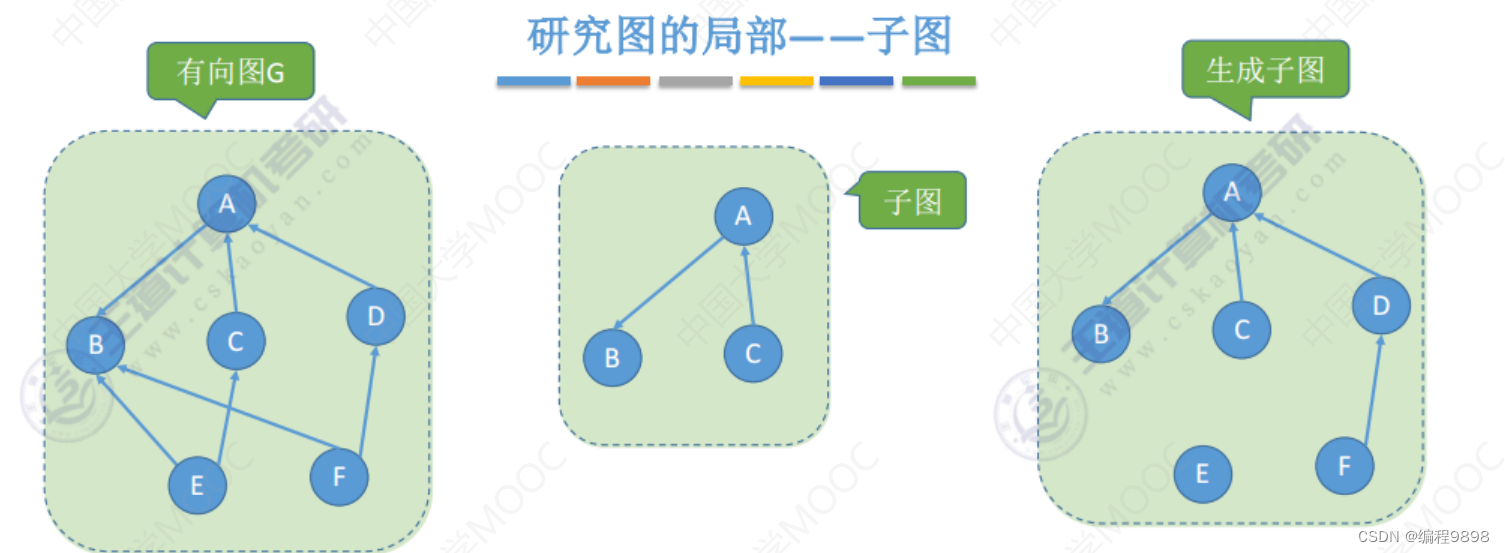目录
1. 栈
1.1 栈的概念及结构
栈:一种特殊的线性表,其只允许在固定的一端进行插入和删除元素操作。进行数据插入和删除操作的一端称为栈顶,另一端称为栈底。栈中的数据元素遵守后进先出LIFO(Last In First Out)的原则。
压栈:栈的插入操作叫做进栈/压栈/入栈。入数据在栈顶。
出栈:栈的删除操作叫做出栈。出数据也在栈顶。
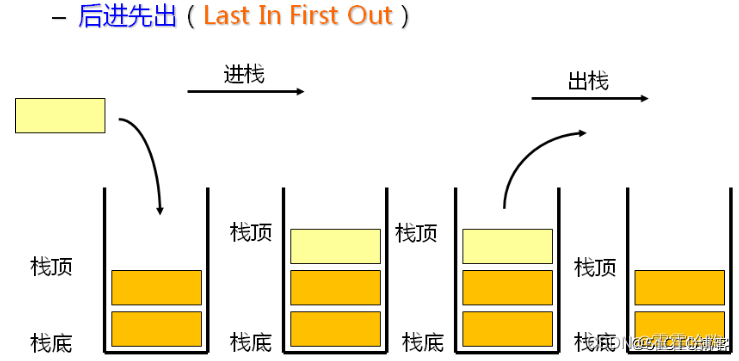
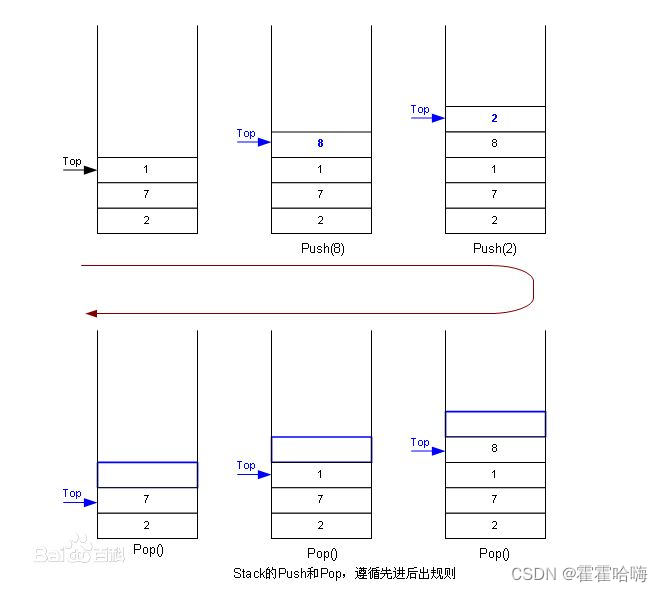
1.2 栈的实现
栈的实现一般可以使用数组或者链表实现,相对而言数组的结构实现更优一些。因为数组在尾插和头删的实际复杂度为O(1),是非常合适的。

1.3 栈的功能
- 初始化栈
- 销毁栈
- 入栈
- 出栈
- 获取栈顶元素
- 获取栈内有效元素的个数
- 判断栈内是否为空,如果为空返回非0结果,不为空返回0
1.4 栈的功能的实现
(1)定义一个动态增长的栈
typedef int STDataType;
typedef struct Stack
{
STDataType* a;
STDataType top;//定义栈顶
size_t capacity;//栈的容量
}ST;
(2)初始化栈
void StackInit(ST* ps)
{
//初始化空间
ps->a = (STDataType*)malloc(sizeof(STDataType) * 4);
if (ps->a == NULL)
{
printf("malloc fail!\n");
return;
}
ps->top = 0;
ps->capacity = 4;//初始化4个空间
}
(3)销毁栈
void StackDestory(ST* ps)
{
free(ps->a);
ps->a = NULL;
ps->capacity = 0;
ps->top = 0;
}
(4)入栈(相当于顺序表的尾插)
void StackPush(ST* ps, STDataType x)
{
//插入数据之前判断是否增容
if (ps->top == ps->capacity)
{
STDataType* tmp = (STDataType*)realloc(ps->a, ps->capacity * sizeof(STDataType) * 2);
if (tmp == NULL)
{
printf("realloc fail!\n");
return;
}
else
{
ps->a = tmp;
ps->capacity *= 2;
}
}
ps->a[ps->top] = x;
ps->top++;
}
(5)出栈(相当于顺序表的头删)
void StackPop(ST* ps)
{
assert(ps);//断言,栈内为空则终止程序
ps->top--;
}
(6)获取栈顶元素
STDataType StackTop(ST* ps)
{
assert(ps);//断言,栈内为空则终止程序
assert(ps->top > 0);
return ps->a[ps->top - 1];
}
(7)获取栈内有效元素的个数
int StackSize(ST* ps)
{
assert(ps);
return ps->top;
}
(8)判断栈内是否为空,如果为空返回非0结果,不为空返回0
bool StackEmpty(ST* ps)
{
assert(ps);
return ps->top == 0;
}
1.5 完整代码
Stack.h
#define _CRT_SECURE_NO_WARNINGS
#include <stdio.h>
#include <stdlib.h>
#include <assert.h>
#include <stdbool.h>
typedef int STDataType;
typedef struct Stack
{
STDataType* a;
STDataType top;//定义栈顶
size_t capacity;//栈的容量
}ST;
//初始化栈
void StackInit(ST* ps);
//销毁栈
void StackDestory(ST* ps);
//从栈顶插入数据
void StackPush(ST* ps, STDataType x);
//从栈顶删除数据
void StackPop(ST* ps);
//获取栈顶元素
STDataType StackTop(ST* ps);
//获取栈内有效元素个数
int StackSize(ST* ps);
//判断栈内是否为空,如果为空返回非0结果,不为空返回0
bool StackEmpty(ST* ps);
Stack.c
#define _CRT_SECURE_NO_WARNINGS
#include "Stack.h"
void StackInit(ST* ps)
{
//初始化空间
ps->a = (STDataType*)malloc(sizeof(STDataType) * 4);
if (ps->a == NULL)
{
printf("malloc fail!\n");
return;
}
ps->top = 0;
ps->capacity = 4;//初始化4个空间
}
void StackDestory(ST* ps)
{
free(ps->a);
ps->a = NULL;
ps->capacity = 0;
ps->top = 0;
}
void StackPush(ST* ps, STDataType x)
{
//插入数据之前判断是否增容
if (ps->top == ps->capacity)
{
STDataType* tmp = (STDataType*)realloc(ps->a, ps->capacity * sizeof(STDataType) * 2);
if (tmp == NULL)
{
printf("realloc fail!\n");
return;
}
else
{
ps->a = tmp;
ps->capacity *= 2;
}
}
ps->a[ps->top] = x;
ps->top++;
}
void StackPop(ST* ps)
{
assert(ps);//断言,栈内为空则终止程序
ps->top--;
}
STDataType StackTop(ST* ps)
{
assert(ps);//断言,栈内为空则终止程序
assert(ps->top > 0);
return ps->a[ps->top - 1];
}
int StackSize(ST* ps)
{
assert(ps);
return ps->top;
}
bool StackEmpty(ST* ps)
{
assert(ps);
return ps->top == 0;
}
Test.c
#define _CRT_SECURE_NO_WARNINGS
#include "Stack.h"
void StackTest()
{
ST st;
StackInit(&st);
StackPush(&st, 1);
StackPush(&st, 2);
StackPush(&st, 3);
StackPush(&st, 4);
//打印栈内的数据,由于不能破坏栈的特性,所以不能遍历
while (!StackEmpty(&st))
{
printf("%d ", StackTop(&st));
StackPop(&st);
}
StackDestory(&st);
}
int main()
{
StackTest();
return 0;
}
2. 队列
2.1 队列的概念及结构
队列:只允许在一端进行插入数据操作,在另一端进行删除数据操作的特殊线性表,队列具有先进先出
FIFO(First In First Out)
入队列:进行插入操作的一端称为队尾
出队列:进行删除操作的一端称为队头
2.2 队列的实现
队列也可以数组和链表的结构实现,使用单链表的结构实现更优一些。
因为如果使用数组的结构,出队列在数组头上出数据,这时需要挪动数据,时间复杂度为O(n),效率会比较低。
而单链表的尾插和头删的时间复杂度为O(1),十分合适。
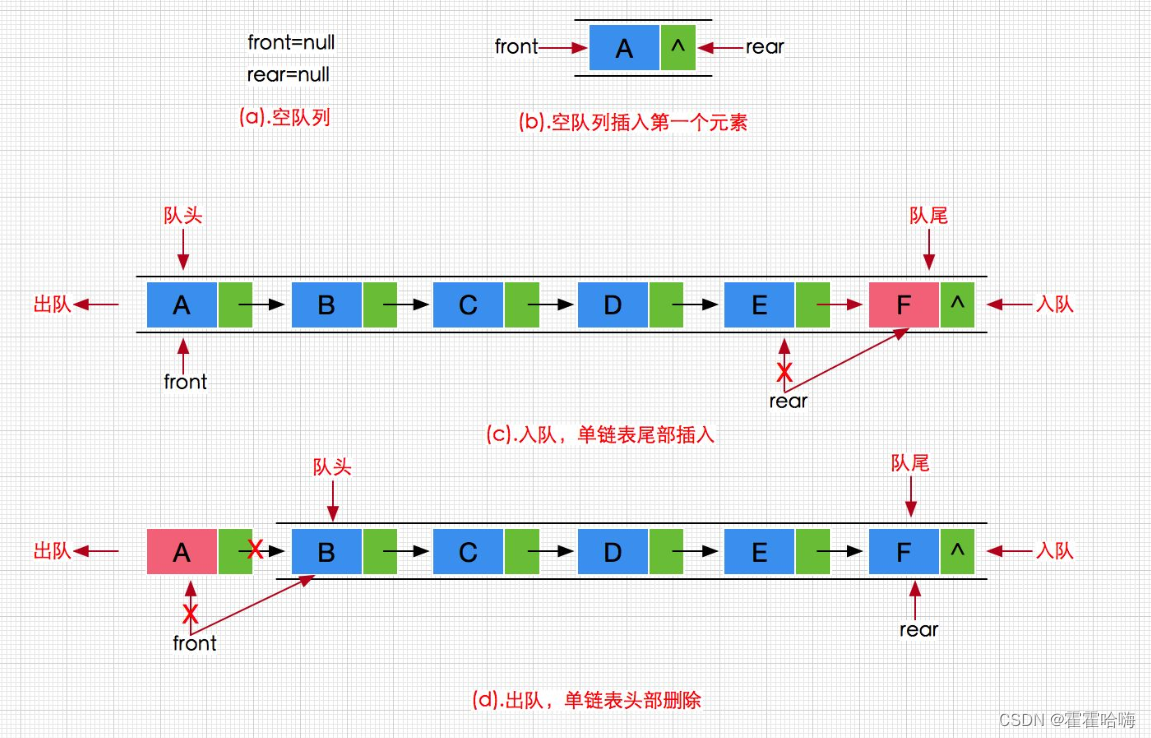
2.3 队列的功能
- 初始化队列
- 销毁队列
- 入队列
- 出队列
- 获取队列头部元素
- 获取队列尾部元素
- 获取队列中有效元素的个数
- 判断队列是否为空,为空返回非0,不为空返回0
2.4 队列的功能的实现
(1)定义一个队列
typedef int QTDataType;
typedef struct QNode
{
struct QNode* next;
QTDataType data;
}QNode;
typedef struct Queue
{
struct QNode* tail;
struct QNode* head;
}Queue;
(2)初始化队列
void QueueInit(Queue* pq)
{
assert(pq);
pq->head = pq->tail = NULL;
}
(3)销毁队列
void QueueDestory(Queue* pq)
{
assert(pq);
QNode* cur = pq->head;
while (cur)
{
cur = cur->next;
free(cur);
}
pq->head = pq->tail = NULL;
}
(4)入队列(相当于单链表的尾插)
void QueuePush(Queue* pq, QTDataType x)
{
assert(pq);
QNode* newnode = (QTDataType*)malloc(sizeof(QTDataType));
if (newnode == NULL)
{
printf("malloc fail!\n");
return;
}
newnode->data = x;
newnode->next = NULL;
//第一个结点
if (pq->tail == NULL)
{
pq->head = pq->tail = newnode;
}
//多个节点
else
{
pq->tail->next = newnode;
pq->tail = newnode;
}
}
(5)出队列(相当于单链表的头删)
void QueuePop(Queue* pq)
{
assert(pq);
assert(pq->head);
//只有一个节点
if (pq->head->next == NULL)
{
free(pq->head);
pq->head = pq->tail = NULL;
}
else
{
//保存下一个节点的地址
QNode* next = pq->head->next;
free(pq->head);
pq->head = next;
}
}
(6)获取队列头部元素
QTDataType QueueFront(Queue* pq)
{
assert(pq);
assert(pq->head);
return pq->head->data;
}
(7)获取队列尾部元素
QTDataType QueueBack(Queue* pq)
{
assert(pq);
assert(pq->head);
return pq->tail->data;
}
(8)获取队列中有效元素的个数
int QueueSize(Queue* pq)
{
assert(pq);
int size = 0;
QNode* cur = pq->head;
while (cur)
{
size++;
cur = cur->next;
}
return size;
}
(9)判断队列是否为空,为空返回非0,不为空返回0
int QueueEmpty(Queue* pq)
{
assert(pq);
return pq->head == NULL;
}
2.5 完整代码
Queue.h
#pragma once
#include <stdio.h>
#include <stdlib.h>
#include <assert.h>
#include <stdbool.h>
typedef int QTDataType;
typedef struct QNode
{
struct QNode* next;
QTDataType data;
}QNode;
typedef struct Queue
{
struct QNode* tail;
struct QNode* head;
}Queue;
//初始化队列
void QueueInit(Queue* pq);
//销毁队列
void QueueDestory(Queue* pq);
//队尾入队列
void QueuePush(Queue* pq, QTDataType x);
//队头出队列
void QueuePop(Queue* pq);
//获取队列头部元素
QTDataType QueueFront(Queue* pq);
//获取队列尾部元素
QTDataType QueueBack(Queue* pq);
//判断队列是否为空,为空返回非0,不为空返回0
int QueueEmpty(Queue* pq);
//获取队列中有效元素的个数
int QueueSize(Queue* pq);
Queue.c
#define _CRT_SECURE_NO_WARNINGS
#include "Queue.h"
void QueueInit(Queue* pq)
{
assert(pq);
pq->head = pq->tail = NULL;
}
void QueueDestory(Queue* pq)
{
assert(pq);
QNode* cur = pq->head;
while (cur)
{
cur = cur->next;
free(cur);
}
pq->head = pq->tail = NULL;
}
void QueuePush(Queue* pq, QTDataType x)
{
assert(pq);
QNode* newnode = (QTDataType*)malloc(sizeof(QTDataType));
if (newnode == NULL)
{
printf("malloc fail!\n");
return;
}
newnode->data = x;
newnode->next = NULL;
//第一个结点
if (pq->tail == NULL)
{
pq->head = pq->tail = newnode;
}
//多个节点
else
{
pq->tail->next = newnode;
pq->tail = newnode;
}
}
void QueuePop(Queue* pq)
{
assert(pq);
assert(pq->head);
//只有一个节点
if (pq->head->next == NULL)
{
free(pq->head);
pq->head = pq->tail = NULL;
}
else
{
//保存下一个节点的地址
QNode* next = pq->head->next;
free(pq->head);
pq->head = next;
}
}
int QueueEmpty(Queue* pq)
{
assert(pq);
return pq->head == NULL;
}
QTDataType QueueFront(Queue* pq)
{
assert(pq);
assert(pq->head);
return pq->head->data;
}
QTDataType QueueBack(Queue* pq)
{
assert(pq);
assert(pq->head);
return pq->tail->data;
}
int QueueSize(Queue* pq)
{
assert(pq);
int size = 0;
QNode* cur = pq->head;
while (cur)
{
size++;
cur = cur->next;
}
return size;
}
Test.c
#define _CRT_SECURE_NO_WARNINGS
#include "Queue.h"
void QueueTest()
{
Queue q;
QueueInit(&q);
QueuePush(&st, 1);
QueuePush(&st, 2);
QueuePush(&st, 3);
QueuePush(&st, 4);
//打印队列内的数据,由于不能破坏队列的特性,所以不能遍历
while (!QueueEmpty(&st))
{
printf("%d ", QueueFront(&st));
QueuePop(&st);
}
QueueDestory(&q);
}
int main()
{
QueueTest();
return 0;
}

